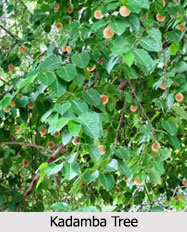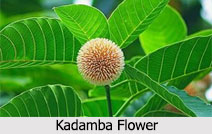 Kadamba tree (Neolamarckia cadamba) is an evergreen, tropical tree which is native to South and Southeast Asia. The scientific name of the tree is "Neolamarckia cadamba" with English common names burflower-tree, laran, and Leichhardt pine. Kadamba tree has scented flowers in dense globe-shaped clusters. The flowers are used in perfumes. The tree is grown as an ornamental plant and for timber and paper-making. Kadamba tree features in Indian religions and mythologies.
Kadamba tree (Neolamarckia cadamba) is an evergreen, tropical tree which is native to South and Southeast Asia. The scientific name of the tree is "Neolamarckia cadamba" with English common names burflower-tree, laran, and Leichhardt pine. Kadamba tree has scented flowers in dense globe-shaped clusters. The flowers are used in perfumes. The tree is grown as an ornamental plant and for timber and paper-making. Kadamba tree features in Indian religions and mythologies.
Description of Kadamba Tree
A fully mature Kadamba tree can reach up to 45 m in height. It is a large tree with a broad crown and straight cylindrical bole. Kadamba tree is quick growing, with broad spreading branches and grows rapidly in the first 6 to 8 years. The diameter of the trunk is 100 to 160 cm; leaves measures 13 to 32 cm in length. Kadamba flowers start to grow when the tree is of 4 or 5 years of age. Flowers have a sweet fragrance with red to orange colour. Fruits of Kadamba tree occur in small and fleshy capsules which contain around 8000 seeds in them. When the fruits become mature, they split apart and release the seeds, which are then dispersed by wind or rain.
Ecology of Kadamba Tree
Kadamba trees are mostly seen in the areas of Southern China, India, Bangladesh, Nepal, Sri Lanka, Cambodia, Laos, Myanmar, Thailand, Vietnam, Indonesia, Malaysia, Papua New Guinea, and Australia.
 Symbolism of Kadamba Tree
Symbolism of Kadamba Tree
The Kadamba tree, characterized by its distinctive symbolism, played a significant role in various facets of Indian history and culture. Notably, the kadamba flower held a position of eminence as the emblem of Athmallik State, a prominent princely state within the landscape of British Raj India.
Moreover, the kadamba tree`s influence extended beyond mere aesthetics. It bestowed its name upon the Kadamba Dynasty, a ruling lineage that held sway over Banavasi, presently situated in the state of Karnataka. This dynasty`s reign, spanning from 345 CE to 525 CE, is meticulously recorded in the Talagunda inscription dated around 450 CE. Within the Kadamba Dynasty, the kadamba tree ascended to the status of a revered entity, gaining recognition as a sacred tree.
Steeped in Hindu tradition, the kadamba tree`s association with the celestial spheres is particularly intriguing. Within the cosmological framework of 27 nakshatras, constituting 12 Houses (Rasis) and nine planets, each star finds its precise representative in a designated tree. The kadamba tree, in this intricate schema, takes on the role of representing Shatabhisha, a nakshatra that aligns roughly with Aquarii.
Usage of Kadamba Tree
The Kadamba tree offers a range of uses that have made it a valuable asset in various domains. Both its botanical components and its cultural significance have contributed to its popularity. The fruit and inflorescences of the Kadamba tree have been identified as edible for human consumption, with the added allure of a fragrant and slightly tangy taste. This appealing flavor profile has led to its consumption in Northern Indian delicacy. Moreover, the tree`s fresh leaves have found a purpose beyond culinary realms, as they are utilized as fodder for cattle.
Beyond its nutritional contributions, the Kadamba tree`s wood has demonstrated exceptional utility. Highly regarded for its quality, the wood is employed in an array of applications. Notably, it is used in plywood, light construction, and the production of boxes, crates, and furniture components. The wood`s versatile nature extends to its workability, as it can be effectively shaped using both manual and mechanical tools. It possesses a fine to medium texture, a straight grain, and a lack of distinctive aroma or taste. Kadamba wood exhibits efficient drying properties and is conducive to preservation techniques, whether through open tank methods or pressure-vacuum systems. The addition of synthetic resins serves to enhance the wood`s density and compressive strength, further expanding its potential applications.
Kadamba trees have become a familiar sight in tropical regions due to their frequent planting. The trees are strategically placed along avenues, roadsides, and within villages to provide essential shade. Moreover, they are deemed suitable candidates for reforestation initiatives. The trees` remarkable influence extends to the soil beneath their canopy, as the substantial leaf and non-leaf litter they shed upon decomposition enriches the soil`s chemical and physical properties. This enhancement is evidenced by heightened levels of soil organic carbon, cation-exchange capacity, available plant nutrients, and exchangeable bases.
The Kadamba tree has also found its place in traditional practices and industries. Its root bark yields a yellow dye, while its flowers serve as a pivotal ingredient in the production of `attar`, an Indian perfume with a base of sandalwood (Santalum spp.). This precious essence is extracted through hydro-distillation. Meanwhile, an extract derived from the leaves functions as a mouth gargle, highlighting its utility in oral care. The bulbous fruit, which carries the flowers, contributes to the tree`s versatility by offering a delectable and fragrant treat. This fruit is enjoyed raw in Northern India and boasts a sweet, tangy taste.
Recent advancements have further showcased the Kadamba tree`s potential. Extracts from its leaves have been harnessed to produce silver nanoparticles used in surface-enhanced Raman spectroscopy. This innovation bridges traditional uses with contemporary scientific applications, emphasizing the tree`s enduring significance.
Religious Significance of Kadamba Tree
Embodied within the Bhagavata Purana, Kadamba tree stands as a symbol of spiritual connectivity that spans across regions and traditions. In North India, it becomes closely intertwined with the divine persona of Krishna, while in the southern part of the country, it is venerated as "Parvati`s tree," embodying both sacredness and mythological allure.
Immersed in the ethereal realm of love and devotion, the kadamba tree witnessed the enchanting tales of Radha and Krishna. It is believed that the celestial canopy of its sweet-scented shade served as a backdrop for their playful and amorous encounters. The Kadamba tree`s role as a silent witness to these divine expressions underscores its status as a witness to the intimate relationships that traverse the human and the divine.
According to one legend, Kadambaba tree is a type of mythical tree, which is assumed to be the `Tree of Buddhism`. The association of Kadambaba tree with Lord Krishna also has been established by some experts. The exotic dance of Krishna with her soul mate Radha and his darling gopis under the Kadambaba tree is often represented in miniature paintings. The Kadambaba tree is held consecrated by the devotees of Lord Krishna and its flowers are used as offerings at various temples. A Kadambaba tree therefore stands as a symbol of reuniting parted lovers.
Several legends related to the Kadambaba tree are also famous. Under the Kadmba tree, Krishna has been seen to swing from the branches and dance in festivity with all the milkmaids of Vrindavana. There is another interesting story popular about the Kadambaba tree. In order to tackle the King of snakes, Lord Krishna arrived at the place with other cowherd boys. He had climbed the huge Kadambaba tree and jumped into the toxic waters of the Yamuna.
A remarkable episode from the life of Krishna casts the Kadamba tree as a pivotal character. The incident of Krishna playfully pilfering the garments of the bathing gopis and draping them upon the branches of the Kadamba tree serves as a lesson in modesty and decorum. This event, portrayed through various artistic mediums, unfolds in the tranquil embrace of the Kadamba tree, forever linking it to Krishna`s moral teachings.
During the Sangam period in Tamil Nadu, the Kadamba tree finds a connection with the revered Murugan of Tirupparankundram Hill in Madurai. As a central figure in nature worship, Murugan was envisioned in the form of a spear beneath the Kadamba tree. This portrayal further illustrates the Kadamba tree`s profound role in encapsulating the essence of natural veneration and spiritual devotion.
The Kadamba tree extends its influence to the realm of festivals as well. The Karam-Kadamba festival, celebrated during the eleventh lunar day of Bhadra, involves the worship of a Kadamba twig in the household courtyard. This gesture signifies the harvest`s bounty and fosters communal sharing, connecting humans with nature`s cycles. This custom finds regional variants in festivals like Onam in Kerala and Huttari in Kodagu.
Kadambotsava, the "Festival of Kadamba," stands as a commemorative tribute to the Kadamba kingdom in Karnataka, celebrating its historical and cultural legacy. This annual event acknowledges the kingdom`s pivotal role in the cultural landscape of the region and highlights the Kadamba tree`s emblematic importance.
The Kadamba tree`s veneration culminates in its association with the deity Kadambariyamman, a guardian presence enshrined within the Meenakshi Amman Temple. In this sacred space, the Kadamba tree finds a home, embodying the essence of the place and its spiritual resonance.











